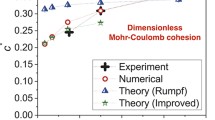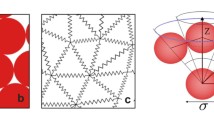Abstract
Suspensions consisting of particles of colloidal dimensions have been reported to form connected structures. When attractive forces act between particles in suspension they may flocculate and, depending on particle concentration, shear history and other parameters, flocs may build-up in a three-dimensional network which spans the suspension sample. In this paper a floc network model is introduced to interpret the elastic behavior of flocculated suspensions at small deformations. Elastic percolation concepts are used to explain the variation of the elastic modulus with concentration. Data taken from the suspension rheology literature, and new results with suspensions of magnetic γ-Fe2O3 and non-magnetic α-Fe2O3 particles in mineral oil are interpreted with the model proposed.
Non-zero elastic modulus appeared at threshold particle concentrations of about 0.7 vol.% and 0.4 vol.% of the magnetic and non-magnetic suspensions, respectively. The difference is attributed to the denser flocs formed by magnetic suspensions. The volume fraction of particles in the flocs was estimated from the threshold particle concentration by transforming this concentration into a critical volume concentration of flocs, and identifying this critical concentration with the theoretical percolation threshold of three-dimensional networks of different coordination numbers. The results obtained indicate that the flocs are low-density structures, in agreement with cryo-scanning electron micrographs. Above the critical concentration the dynamic elastic modulus G′ was found to follow a scaling law of the type G′ ∼ (Φ f -Φ c f )f, where Φ f is the volume fraction of flocs in suspension, and Φ c f is its threshold value. For magnetic suspensions the exponent f was found to rise from a low value of about 1.0 to a value of 2.26 as particle concentration was increased. For the non-magnetic a similar change in f was observed; f changed from 0.95 to 3.6. Two other flocculated suspension systems taken from the literature showed a similar change in exponent. This suggests the possibility of a change in the mechanism of stress transport in the suspension as concentration increases, i.e., from a floc-floc bond-bending force mechanism to a rigidity percolation mechanism.
Similar content being viewed by others
References
Adam M, Delsanti M, Durand D, Hild G, Munch JP (1981) Mechanical properties near gelation threshold, comparison with classical and 3 D percolation theories. Pure Appl Chem 53:1489–1494
Buscallu R, Mills PDA, Goodwin JW, Lawson DW (1988) Scaling behavior of the rheology of aggregate networks formed from colloidal particles. J Chem Soc, Faraday Trans 1 84 (12):4249–4260
de Gennes PG (1976) On the relation between percolation theory and the elasticity of gels. J Phys (Paris) 37:L1-L2
Deptuc D, Harrison JP, Zawadzki P (1985) Measurement of the elasticity and conductivity of a three-dimensional percolation system. Phys Rev Lett 54:913–916
Feng S, Sen P, Halperin BI, Lobb CJ (1984) Percolation on two-dimensional elastic networks with rotationally invariant bond-bending forces. Phys Rev B 30:5386–5389
Feng S, Sen P (1984) Percolation on elastic networks: new exponent and threshold. Phys Rev Lett 52:216–219
Firth BA (1976) Flow properties of coagulated colloidal suspensions II. Experimental properties of the flow curve parameters. J Colloid Interface Sci 57:257–265
Firth BA, Hunter RJ (1976) Flow properties of coagulated colloidal suspensions III. The elastic floc model. J Colloid Interface Sci 57:266–275
Firth BA, Hunter RJ (1976) Flow properties of coagulated colloidal suspensions I. Energy dissipation in the flow units. J Colloid Interface Sci 57:248–256
Jerauld GR (1985) Flow and transport in chaotic media: four case studies. Ph. D. thesis, Univ of Minnesota, available from University Microfilms International, Ann Arbor, MI
Kamphuis H, Jongshaap RJJ, Bouter J (1984) The relation between the permeability of structured dispersions and the viscoelastic properties of the dispersed phase. J Colloid Interface Sci 98:459–466
Kantor Y, Webman I (1984) Elastic properties of random percolating systems. Phys Rev Lett 52:1891–1894
Keating PN (1966) Effect of invariance requirement on the elastic strain energy of crystals with application to the diamond structure. Phys Rev 145:637–645
Kirkpatrick S (1973) Percolation and conduction. Rev Mod Phys 45:574–588
Kittel C (1950) Introduction to solid state physics, 2nd ed. John Wiley and Sons, New York
Mall S, Russel WB (1987) Effective medium approximation for an elastic network model of flocculated suspensions. J Rheol 31 (8):651- 681
Mewis J, Spaull AJB (1976) Rheology of concentrated dispersions. Adv Colloid Interface Sci 6:173–200
Michaels AS, Bolger JC (1962) The plastic flow behavior of flocculated kaolin suspensions. I & EC Fundam 1:153–162
Navarrete R (1991) Rheology and structure of flocculated suspensions. Ph. D. thesis, Univ of Minnesota, available from University Microfilms International, Ann Arbor, MI
Papenhuizen JMP (1972) The role of particle interactions in the rheology of dispersed systems. Rheol Acta 11:73–88
Phillips JC, Thorpe MF (1985) Constraint theory, vector percolation and glass formation. Solid State Comm 53:699–702
Sahimi M (1984) Transport and dispersion in porous media and related aspects of petroleum recovery. Ph. D. thesis, Univ of Minnesota, available from University Microfilms International, Ann Arbor, MI
Schoukens G, Mewis J (1978) Nonlinear theological behaviour and shear-dependent structure in colloidal dispersions. J Rheol 22:381–394
Sen P, Thorpe MF (1977) Phonons in AX2 glasses: from molecular to band-like modes. Phys Rev B 15:4030–4038
Seto J (1977) Rheology of magnetic paint. J Soc Rheol (Japan) 5:156–162
Sheehan JG, Scriven LE, Bailey GW (ed) (1988) Cryo-SEM of particulate suspensions. Proceedings of the 46th Annual Meeting of the Electron Microscopy Society of America, San Francisco, California pp 102–103
Smith TL, Bruce CA (1979) Intrinsic viscosities and other theological properties of flocculated suspensions of nonmagnetic and magnetic ferric oxides. J Colloid Interface Sci 72:13–26
Steenberg B, Thalen N, Wahren D (1965) Formation and properties of fibre networks. In Consolidation of Paper Web vol 1. Trans Symp, Bolaw F (ed), Cambridge, England, pp 177–197
Thorpe MF (1985) Rigidity percolation. Physics of disordered materials. D Adler et al, eds. Plenum Press, pp 55–61
Utsugi H, Endoh A, Suzuki N, Ono K (1985) Surface-treatment of ceramic powders and their surface properties. III The surface-treatment of γ-hematite with alkoxysilane and their surface properties. J of Japan Society of Powder and Powder Metallurgy 32:100–103
van de Ven TGM, Hunter RJ (1977) The energy dissipation in sheared coagulated sols. Rheol Acta 16:534–543
Wildemuth CR, Williams MC (1985) A new interpretation of viscosity and yield stress in dense slurries: coal and other irregular particles. Rheol Acta 24:75–91
Wong RBK, Lelievre J (1981) Viscoelastic behavior of wheat starch pastes. J Rheol Acta 20:299–307
Yang M-C, Scriven LE, Macosko CW (1986) Some rheological measurements. J Rheology 30:1015–1029
Zosel A (1982) Rheological properties of dispersed systems at low shear stress. Rheol Acta 21:72–80
Author information
Authors and Affiliations
Rights and permissions
About this article
Cite this article
Kanai, H., Navarrete, R.C., Macosko, C.W. et al. Fragile networks and rheology of concentrated suspensions. Rheola Acta 31, 333–344 (1992). https://doi.org/10.1007/BF00418330
Received:
Revised:
Issue Date:
DOI: https://doi.org/10.1007/BF00418330




